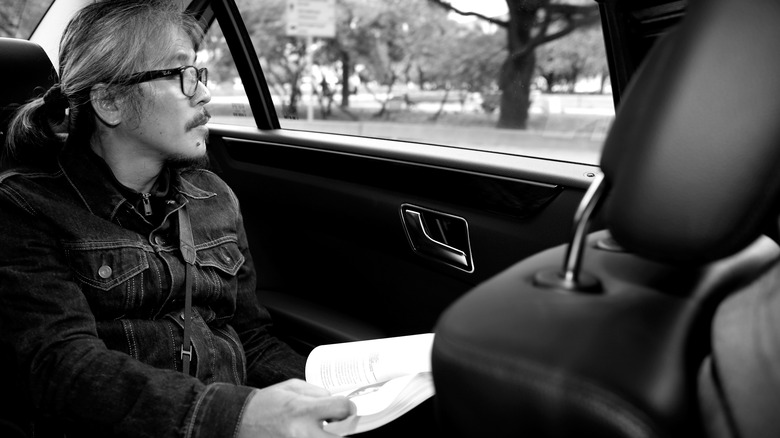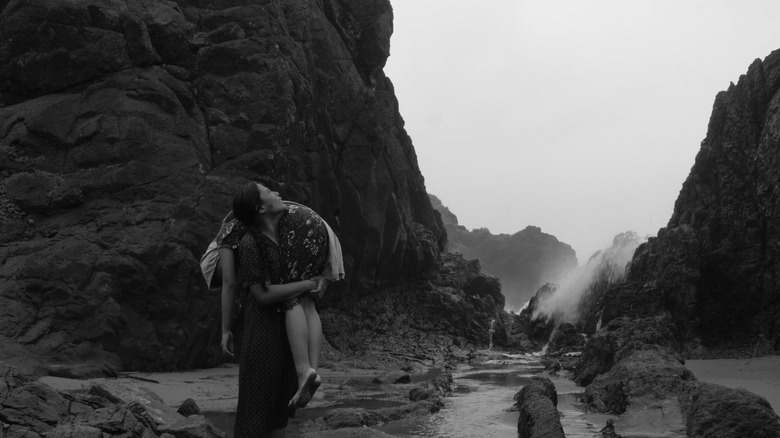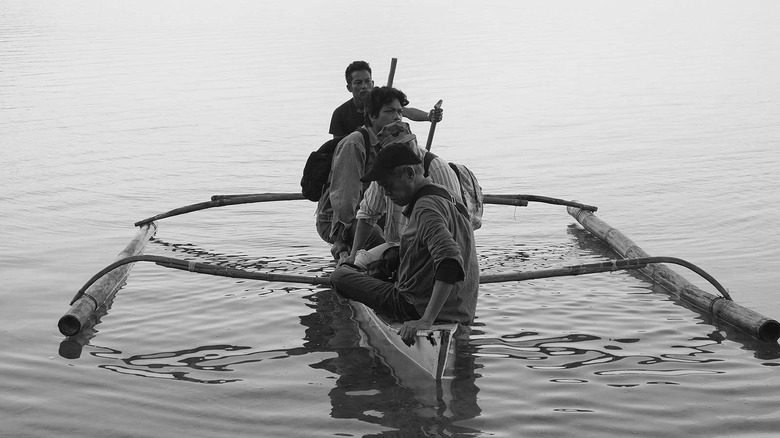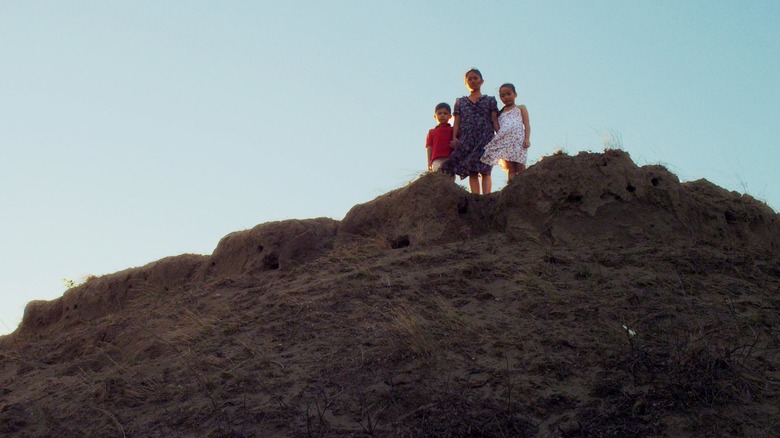Meet Lav Diaz, The Director Who Makes 647-Minute Long Movies
2022 will see the release of "Servando Magdamag" and "When the Waves Are Gone," two new films from director Lav Diaz. This is a cause for celebration, and an opportunity for this budding Lav Diaz fanboy to share.
Articles about Filipino filmmaker Lav Diaz typically begin by noting the prodigious length of his films, and it appears this one is no different. Lav Diaz has made 27 feature films as a director, and at least eight of them are over five hours long, with his 2004 film "Evolution of a Filipino Family" running 647 minutes, one of the longest non-experimental films in cinema history. That's close to 11 hours. That's only slightly shorter than the first seven "Nightmare on Elm Street" movies combined. You could watch "Titanic" three times in that span, and still have room to fit in "Dumbo." That's about 323 Quibis. Additionally, Diaz's 2006 film "Heremias" is 519 minutes, his 2007 film "Death in the Land of Encantos" is 541 minutes, and his 2016 film "A Lullaby to the Sorrowful Mystery" is 489 minutes.
But with the churlish part out of the way, Lav Diaz is perhaps the world's most celebrated Filipino filmmaker. He has also been called one of the most important artists of the 20th century, having received several honors from the Venice Film Festival, and whose 2014 film "Norte, the End of History" was nominated for the Prix Un Certain Regard at Cannes.
Oh Hi Marcos
Diaz's films, while seen by festival-goers and ambitious cineastes who are able to carve out entire days to watch his movies, are not widely distributed into traditional film markets, not only because of their length — although that is a huge factor — but because of their difficult subject matter. Many of Diaz's films address fascism, specifically that of the Ferdinand Marcos administration. Marcos, briefly, was a dictator of The Philippines who was elected president in 1968 and who established martial law in 1972. He and his wife Imelda stole the country's money for himself, and used violent means to snuff out any political opposition, any suspected communists, dissidents, and, just to scoop in a little handful of bigotry, Muslims. Several of Lav Diaz's films use the Marcos regime as a backdrop for actions that may seem far removed from Filipino politics, but are connected to them like a central vein in the same corrupted body. This can be seen in what might be considered a thematic trilogy, presented in a reverse historical chronology:
Diaz's 2001 film "Batang West Side," is a crime drama set in Jersey City, wherein a detective investigating the slaying of a Filipino teen discovers the bleakness of the Filipino diaspora. The echoes of the Marcos regime, and the horrors of the dictatorship linger and seem to inform everything. "Batang West Side" was one of the few films Diaz shot on 35mm film. Diaz's magnum opus "Evolution of a Filipino Family," traces the family of the title throughout the whole of the Marcos dictatorship from 1972 up until 1987. And 2014's "From What is Before" (338 minutes) takes place in a remote Filipino village surrounded by jungles, and depicts how the suspicion and violence of the faraway dictatorship seems to be leaking into the consciousnesses of the people in this village; it's essentially a dictatorship origin story and, like Michael Haneke's "The White Ribbon," traces how agrarian resentment and spiritual hysteria can lead to broader habits toward fascism.
It's f***in' awesome.
Lav Diaz's Style
Although Diaz's most celebrated film, "Norte, the End of History" is shot in color (by Lauro Rene Manda), most of Diaz's films are shot in a glittering, detailed digital black and white. Diaz tends to feature few close-ups, locking down his camera near a gorgeous and forbidding natural vistas and letting shots linger for 10 to 15 minutes. Into these natural vistas, we may see a single human quietly enter, so inhabiting the background as to become part of it. Humanity is just as much a part of gorgeous and forbidding natural landscapes at the dirt and the trees. Often, humanity will also take on the brutality of nature as well. In his most recent film to be distributed in the United States, "Genus, Pan," (practically a trifle at 157 minutes) we see three men trekking across their home island through the jungle as a way of avoiding the local authorities, and end up recalling their time working in theater, and a dark chapter in their lives when they may or may not have committed a murder. "Genus, Pan" seems to point out that humanity may never outgrow its animal brutality, and that we are hardwired for entropy.
Starting with "Evolution of a Filipino Family," Diaz has served as his own writer and editor on all his films, and as producer and cinematographer on most of them. Diaz is often cited — along with Béla Tarr, Andrei Tarkovsky, Tsai Ming-liang, and Apichatpong Weerasethakul — as one of the working masters of the Slow Cinema aesthetic. Slow Cinema, true to its name, is film devoted not to ramping up or exciting an audience, but lulling them into a meditative state. Slow Cinema puts audiences into a state of acceptance, of observation. When we see a shot of a woman carrying a bushel of grain on her back, and it lasts 10 minutes, we enter a state of ecstatic truth; that is not a cinematic interpretation of a person struggling. It is a person struggling. Slow Cinema is a tough sell for those raised on incident, plot, and a certain kind of action-forward cinematic language, but, if one is open to the experience, one will find that being slowed down can be sublime. Your mind will soon be searching the frame for new details, appreciating the way the wind moves a tree or the way an ocean is all too ready to swallow a human life. It's beautiful.
Also, given Diaz's habits for telling long-form stories about a generation of a family or a village, it's tempting — and apt — to compare his work to Tolstoy or Dostoyevsky. There is something gorgeously literate and novelistic about Diaz' approach to cinema. Long and complicated stories about the entropy of the human consciousness, the corruption of the Marcos regime, and the ineffable sadness that underlines it all.
Like I said, f***in' awesome.
Where Can I See Lav Diaz Movies?
As mentioned above, Diaz's films have had difficulty finding distribution, but several enterprising online streaming services have been good about getting his work to audiences. The carefully-curated arthouse service Mubi has many of Diaz's films ready to go, including "Evolution of a Filipino Family," "Norte," "From What is Before," "The Halt," "Genus, Pan," "A Century of Birthing," "Florentina Hubaldo, CTE," "Storm Children," "Heremias," "An Investigation on the Night That Won't Forget," "A Lullaby to the Sorrowful Mystery," and "Melancholia."
If you're signed up for Kanopy — which I recommend — you'll be able to see three of Diaz's films, and all the cool kids who signed up for Ovid will be able to at least see "From What is Before."
Indeed, streaming may be more conducive to the consumption of long, slow cinema. You may schedule the film to your liking, and more easily carve out a Saturday to take in all 647 minutes of "Family" or all seven-and-a-half hours of "Melancholia." You may cater an intermission or two. Take a moment to breathe. Stand. Kneel. Sit. Live with it.
Because it's going to be f***in' awesome.



